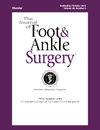Effect of surgery for ankle osteoarthritis on locomotive syndrome
IF 1.3
4区 医学
Q2 Medicine
引用次数: 0
Abstract
Locomotive syndrome (LS) is characterized by a decline in locomotor function due to musculoskeletal disorders. However, few studies have explored its association with ankle osteoarthritis (AOA) or surgical impact. This study evaluated LS and its improvement following corrective osteotomy (CO) or arthrodesis for AOA and compared outcomes between procedures. LS stages, ranging from 0 (healthy) to 3 (most declined), were assessed preoperatively and at 12 months postoperatively using the stand-up test (ability to rise from different heights), two-step test (maximum stride length over two strides), and GLFS-25 (self-reported locomotor function). Pre- and postoperative comparisons and group differences were analyzed, with p < 0.05 considered significant. Forty patients were included. All patients had a preoperative LS stage 1 to 3, with a prevalence of LS stage 3 of 57.5 %. At 12 months after surgery, the prevalence of LS stage 1 to 3 was 95.0 %, but the prevalence of LS stage 3 decreased to 30.0 %. At least one LS stage improved postoperatively in 19 patients (47.5 %). There was no significant difference between pre- and post-operative stand-up test results (p = 0.74), but the two-step test and GLFS-25 improved significantly postoperatively (two step: p = 0.01, GLFS-25: p < 0.001). The GLFS-25 improved significantly postoperatively in both groups (corrective osteotomy: p = 0.001, Arthrodesis: p = 0.01); however, the two-step test improved significantly postoperatively only in the corrective osteotomy group (corrective osteotomy: p = 0.02, Arthrodesis: p = 0.44). In conclusion, ankle osteoarthritis may be a factor affecting LS, and corrective osteotomy tended to be more effective in improving the two-step test.
踝关节骨关节炎手术治疗对运动综合征的影响。
运动综合征(LS)的特征是由于肌肉骨骼疾病引起的运动功能下降。然而,很少有研究探讨其与踝关节骨关节炎(AOA)或手术影响的关系。本研究评估了矫正截骨术(CO)或关节融合术治疗AOA后LS及其改善情况,并比较了两种方法的结果。LS分期,从0(健康)到3(大多数下降),在术前和术后12个月使用站立测试(从不同高度上升的能力),两步测试(两步的最大步长)和GLFS-25(自我报告的运动功能)进行评估。术前、术后比较及组间差异以p < 0.05为差异有统计学意义。纳入40例患者。所有患者术前均为LS 1 - 3期,其中LS 3期患病率为57.5%。术后12个月,LS 1 ~ 3期的发生率为95.0%,而LS 3期的发生率下降至30.0%。19例患者(47.5%)术后至少有一个LS期得到改善。两组患者站立测试结果无显著性差异(p = 0.74),两步测试及GLFS-25明显改善(两步:p = 0.01, GLFS-25: p < 0.001)。两组术后GLFS-25均有显著改善(矫正截骨:p = 0.001,关节融合术:p = 0.01);然而,术后两步测试仅在矫正截骨组有显著改善(矫正截骨:p = 0.02,关节融合术:p = 0.44)。综上所述,踝关节骨性关节炎可能是影响LS的一个因素,而矫正截骨往往更能有效地改善两步测试。证据等级3。
本文章由计算机程序翻译,如有差异,请以英文原文为准。
求助全文
约1分钟内获得全文
求助全文
来源期刊

Journal of Foot & Ankle Surgery
ORTHOPEDICS-SURGERY
CiteScore
2.30
自引率
7.70%
发文量
234
审稿时长
29.8 weeks
期刊介绍:
The Journal of Foot & Ankle Surgery is the leading source for original, clinically-focused articles on the surgical and medical management of the foot and ankle. Each bi-monthly, peer-reviewed issue addresses relevant topics to the profession, such as: adult reconstruction of the forefoot; adult reconstruction of the hindfoot and ankle; diabetes; medicine/rheumatology; pediatrics; research; sports medicine; trauma; and tumors.
 求助内容:
求助内容: 应助结果提醒方式:
应助结果提醒方式:


